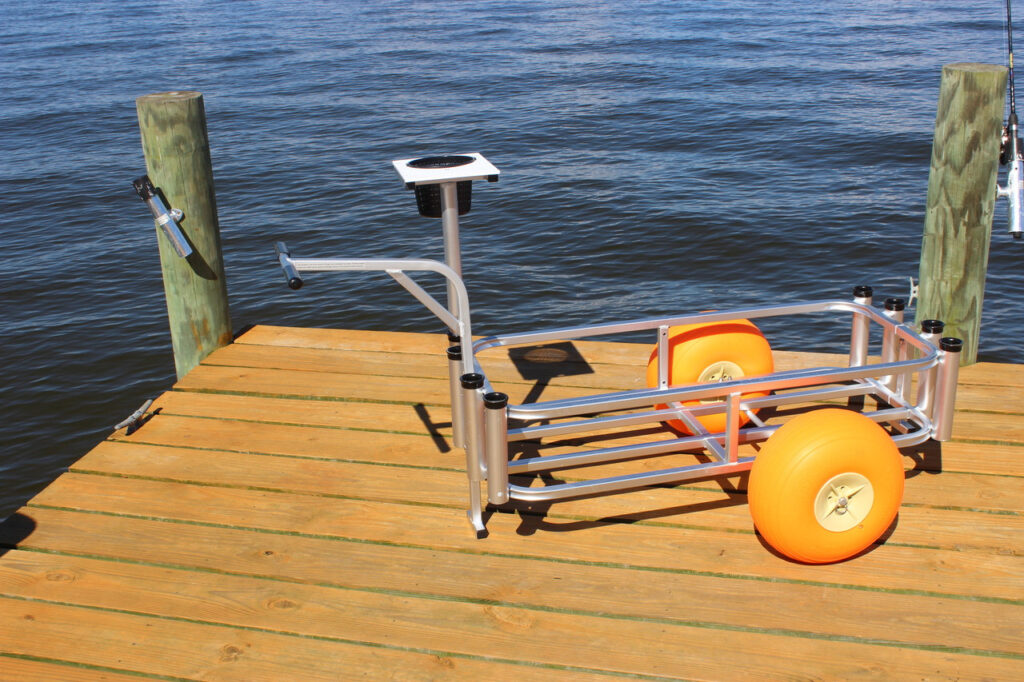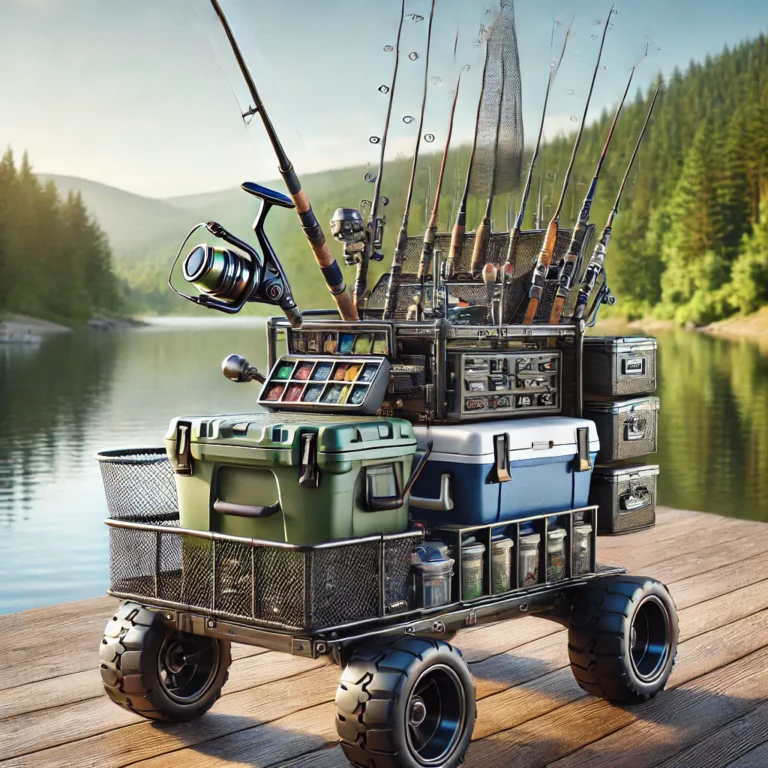Fishing Carts: Revolutionize The Fishing Experience
For those of us who enjoy fishing from the shore, a fishing cart can be an indispensable tool.
These handy carts help transport gear, tackle, and other essentials, making your fishing trips more efficient and enjoyable.
In this comprehensive guide, we’ll explore the ins and outs of fishing carts, their uses, and what to look for when purchasing one.
By the end of this guide, you’ll be well-equipped to choose the perfect fishing cart for your needs.
What Are Fishing Carts?

Fishing carts are specialized wheeled carriers designed to transport fishing gear and supplies.
They come in various sizes and designs, typically featuring sturdy frames, wheels, and compartments to hold rods, tackle boxes, coolers, and other equipment.
Fishing carts are particularly useful for surf fishing, pier fishing, and other shore-based fishing activities where carrying gear over long distances or rough terrain can be challenging.
Types of Fishing Carts
Fishing carts come in several types, each designed to meet specific needs and preferences.
Here are the main types:
- Standard Fishing Carts: These are versatile carts suitable for various fishing environments, including beaches, piers, and jetties. They usually feature a spacious cargo area, rod holders, and sturdy wheels.
- Beach Fishing Carts: Specifically designed for sandy environments, these carts often have balloon-style wheels that can easily traverse soft sand. They are ideal for surf fishing enthusiasts who need to transport gear across the beach.
- Pier Fishing Carts: These carts are tailored for pier fishing, with features like compact designs for easy maneuverability on narrow walkways and built-in rod holders. They often have durable, corrosion-resistant materials to withstand the salty marine environment.
- Heavy-Duty Fishing Carts: Built for anglers with extensive gear, these carts have robust frames and larger cargo capacities. They can carry multiple coolers, tackle boxes, and other heavy equipment, making them perfect for long fishing trips or group outings.
- Folding Fishing Carts: These carts are designed for convenience and portability. They can be folded down for easy storage and transport, making them ideal for anglers with limited storage space or those who travel frequently.
Uses of Fishing Carts
Fishing carts are incredibly versatile and can serve various purposes beyond just carrying fishing gear.
Here are some of the primary uses:
- Transporting Fishing Gear: The most obvious use of a fishing cart is to carry rods, reels, tackle boxes, bait, and other fishing equipment. This allows anglers to transport everything they need in one trip, saving time and effort.
- Carrying Coolers and Food: Many fishing carts are designed with spaces for coolers, making it easy to bring along drinks, snacks, and even fresh bait. This is especially useful for long fishing sessions where staying hydrated and nourished is essential.
- Storing Personal Items: Fishing carts often have additional compartments or pockets for personal items like keys, wallets, phones, and sunscreen. This helps keep valuables safe and easily accessible.
- Assisting with Beach or Pier Setup: For surf fishing, a cart can carry beach chairs, umbrellas, and other items to set up a comfortable fishing spot. Similarly, on piers, a cart can hold extra gear like landing nets or live bait tanks.
- Organizing Equipment: Fishing carts help keep gear organized and within reach. Many models have built-in rod holders, tackle storage, and other features that allow anglers to quickly access their equipment without rummaging through bags or boxes.
Key Features to Consider When Purchasing a Fishing Cart
Choosing the right fishing cart involves considering several factors to ensure it meets your specific needs.
Here are the key features to look for:
1. Weight Capacity
The weight capacity of a fishing cart determines how much gear it can carry. Depending on your fishing style and the amount of equipment you typically bring, you’ll need a cart with an appropriate capacity. For light outings, a cart with a capacity of around 50-100 pounds may suffice. However, for more extensive trips, look for carts that can handle 150 pounds or more.
2. Wheel Type and Size
The type and size of the wheels are crucial, especially if you plan to use the cart on different terrains. Beach fishing carts typically have large, balloon-style wheels that can easily roll over soft sand. For pier or rocky terrain, solid or pneumatic tires with good traction are more suitable. Consider the size of the wheels as well; larger wheels generally provide better maneuverability and stability.
3. Frame Material
The material of the frame affects the cart’s durability and resistance to corrosion. Common materials include:
- Aluminum: Lightweight and resistant to rust, making it ideal for marine environments.
- Steel: Strong and durable, but heavier and prone to rust if not properly treated.
- Plastic: Lightweight and corrosion-resistant but may not be as durable as metal options.
4. Rod Holders
Rod holders are a must-have feature for fishing carts, as they provide a safe and convenient way to transport multiple fishing rods. Look for carts with adjustable or removable rod holders, allowing you to customize the setup based on your needs.
5. Storage and Compartments
Consider the layout and number of compartments available in the cart. Some carts have built-in tackle storage, cooler holders, and additional pockets for accessories. This organization can help keep your gear sorted and easily accessible during your fishing trip.
6. Foldability and Portability
For anglers with limited storage space or those who travel frequently, a foldable fishing cart is a great option. These carts can be collapsed for easy storage in your vehicle or garage. Check the folded dimensions and weight to ensure it fits your storage and transport needs.
7. Ease of Assembly
Some fishing carts require assembly, while others come pre-assembled. Consider how easy it is to put the cart together and whether tools are required. A cart with a simple assembly process can save time and frustration.
8. Price and Warranty
Fishing carts come in a wide range of prices, from budget-friendly options to high-end models. Determine your budget and compare features to find the best value for your money. Additionally, check if the cart comes with a warranty, as this can provide peace of mind and protection against defects.

Tips for Using and Maintaining Your Fishing Cart
Once you’ve selected the perfect fishing cart, proper use and maintenance will ensure it serves you well for many fishing trips to come.
Here are some tips:
- Load Distribution: Evenly distribute the weight of your gear in the cart to maintain balance and prevent tipping. Place heavier items, like coolers, at the bottom and center of the cart.
- Securing Gear: Use bungee cords or straps to secure loose items and prevent them from shifting during transport. This is especially important on uneven terrain or in windy conditions.
- Cleaning and Maintenance: After each use, especially if you’ve been near saltwater, rinse the cart with fresh water to remove sand, salt, and debris. Dry the cart thoroughly to prevent rust and corrosion, and periodically check for any loose screws or worn parts.
- Storing the Cart: Store your fishing cart in a dry, covered area to protect it from the elements. If the cart is foldable, collapse it to save space and protect it from dust and dirt.
- Upgrading and Customizing: As you become more familiar with your fishing cart, you may find opportunities to upgrade or customize it. Adding extra rod holders, modifying the wheels, or creating additional storage compartments can enhance the cart’s functionality and better suit your needs.
Conclusion
A fishing cart is a valuable investment for any shore-based angler, providing a convenient and efficient way to transport gear and enjoy a more organized fishing experience.
By understanding the different types of fishing carts, key features to consider, and proper maintenance practices, you can choose the perfect cart to enhance your fishing adventures.
Whether you’re heading to the beach, pier, or riverbank, a well-chosen fishing cart will make your trips more enjoyable and hassle-free, allowing you to focus on what matters most: catching fish and enjoying the great outdoors.
Those trophy fish aren’t going to land themselves so get out on the water and get busy reeling them in.
Tight lines!


